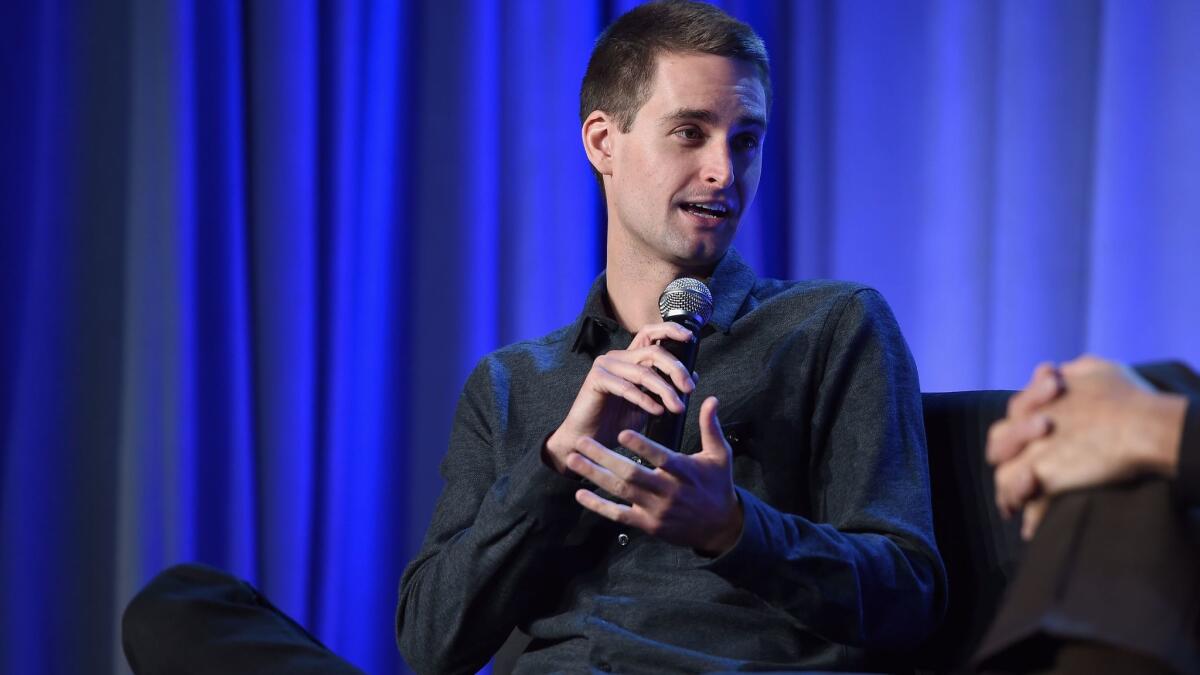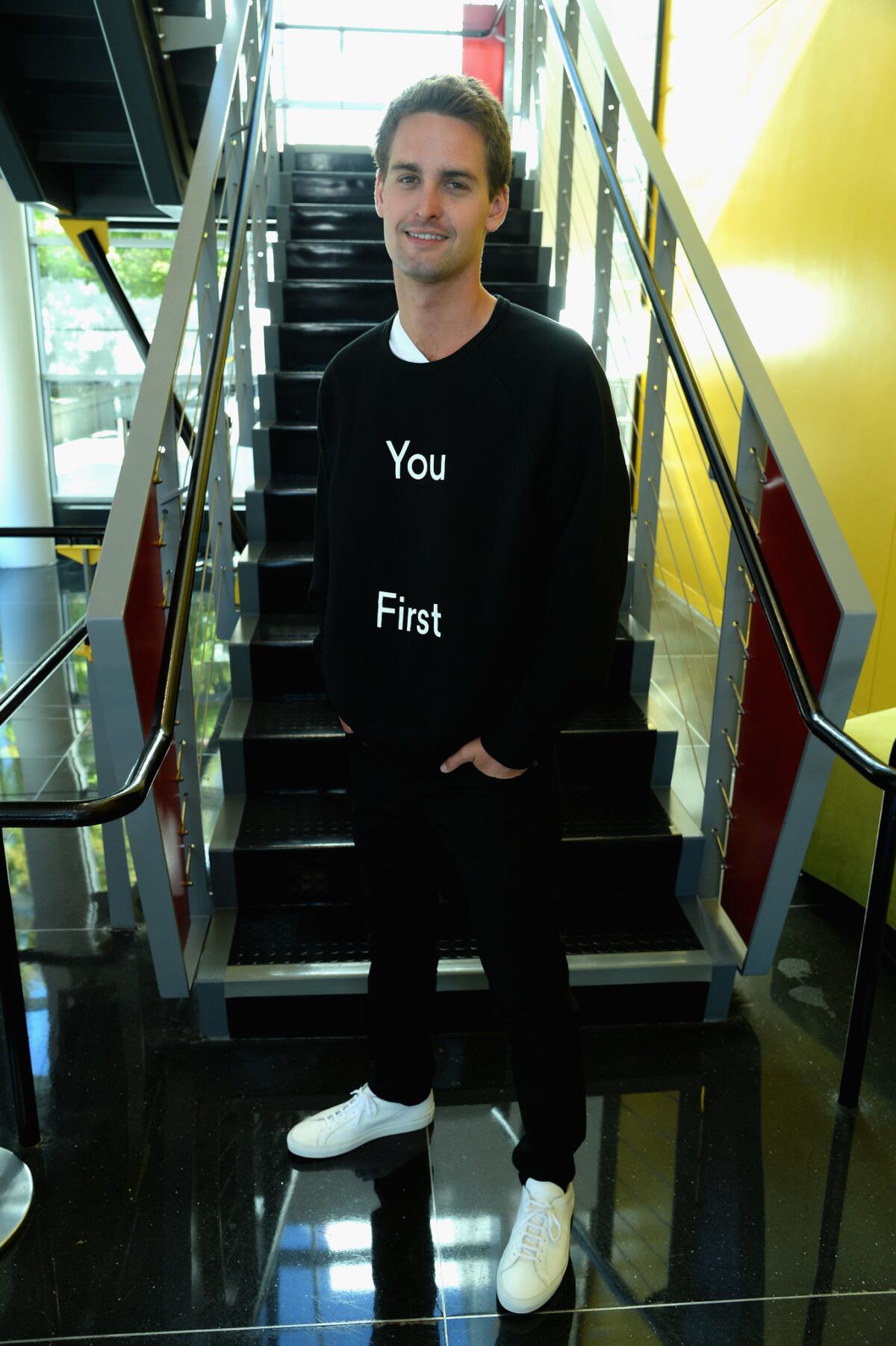There’s one part of Snapchat that Facebook can’t copy: CEO Evan Spiegel

Four years ago, Evan Spiegel made the bet of his life, rejecting Facebook’s $3-billion offer for his fledgling video messaging app,
Facebook responded by moving aggressively to clone what it couldn’t buy. The defining features of Snapchat — disappearing images, playful cartoon graphics and daily video montages — all became Facebook features, too.
That mimicry dominates investor concerns about the stock market debut Thursday of the Venice tech company, now known as Snap Inc. If half the world’s Internet users are on Facebook and it replicates the best of Snapchat, why would people sign up for the smaller service?
To Snap, the answer lies in the trailblazer who turned down the Facebook deal: an enigmatic, 26-year-old who took an app once derided as a sexting tool and sparked a youth phenomenon. So long as Spiegel remains the ultimate decision maker, Snap will outpace and out-innovate its biggest competitor, the company contends.
His vision has led tens of millions of people under age 25 to open Snapchat 20 times a day to reach friends and catch up with what’s happening in the world. Its signature auto-deleting videos encourage spontaneity and carefree self-expression. That’s no small detail to a generation taught from an early age that anything shared on social media can one day be used against them.

Spiegel is “a rare combination of someone who understands the consumer, the product and how to build a company around it,” said MTV co-founder Bob Pittman, currently chief executive and chairman of Snap business partner IHeartMedia. It’s rare, he added, to find someone with both creative and business skills. “And it’s pretty apparent to anyone who’s dealt with Snap that he has infused the entire company with that integrated view.”
A decade ago, Facebook was the rage on college campuses. Now its use among youth is sliding, and it desperately covets Snap’s cachet with the tough-to-reach 12- to 24-year-old demographic, a crucial target for advertisers.
Spiegel’s view of social media is decidedly different from Facebook founder Mark Zuckerberg, who is six years older. But with Facebook racing to catch up, Spiegel is challenging investors to shell out for young and cool at the expense of safe and mainstream.
I'm obviously mortified and embarrassed that my idiotic emails … were made public. They in no way reflect who I am today or my views towards women.
— Evan Spiegel, reflecting on the hacks of his fraternity correspondence
The exclusive Crossroads School for Arts and Sciences in Santa Monica is where the entertainment industry sends its offspring. Dustin Hoffman’s children studied there. So did
Spiegel wanted to be like the celebrities and other rich kids on campus. So he pressed his father for a BMW — he touted its fuel efficiency — to show peers he could “drive a car just as nice as theirs,” according to his parents’ divorce proceedings.
Related: Ignore the hype about the Snap IPO. Here's why it's a sucker's bet »
The son of two lawyers, Spiegel could afford luxury.
He might have been, as he described himself, a shy, nerdy kid who admired the aesthetic of Steve Jobs. But growing up in Pacific Palisades, an entrepreneurial bent did not make him a social outcast. In high school, he threw parties at his father’s home that were large enough to require a security detail.
He was eventually drawn to start-ups and headed to Stanford — Silicon Valley’s most prestigious tech incubator, where he pursued a product design degree and organized the Kappa Sigma fraternity’s parties.
The latter effort splintered his reputation years later when the gossip website Gawker published fraternity emails in which Spiegel glorified crude sexual behavior.
Later, a 2014 cyberattack unearthed emails between Spiegel and Snap board member and then-Sony Entertainment CEO Michael Lynton. Most showed a polite and insightful entrepreneur, but they revealed secrets about Snap’s plans.
The leaks devastated Spiegel, who had grown frustrated that digital trails could so damage an individual — even if the thinking described in them had evolved.
He deleted his Twitter history and attempted to retreat from the spotlight. The boy who wanted to keep up with societal standards of cool became a young man intent on upending the way society judges people.
He nailed it. He saw the stuff that the … MBAs didn’t.
— Scott Cook, co-founder of Intuit
In a class full of Stanford students pursuing master’s degrees in business, the undergraduate in the back was the only person with an interesting take on a case study. Intuit co-founder and guest lecturer Scott Cook became so enamored that he took the unusual step of pairing the student, Spiegel, with an engineer working to make Intuit services more accessible in India. Spiegel lasted a few weeks before his entrepreneurial streak kicked in.
“I realized that if we could accomplish so much with such a small team I was completely crazy not to try it for myself,” Spiegel later recalled.

After many failed ventures, Spiegel’s dorm mate Reggie Brown pitched an idea for sharing auto-deleting photos over the Internet. They looped in Stanford friend Bobby Murphy to handle development, and the three launched what would become Snapchat months later in July 2011. (Brown was ousted that summer, later sued and settled for $158 million.)
They intended to foster online flirting with photos that could be sent for “peeks, not keeps.”
The trio canvassed a mall near Spiegel’s father’s house with fliers, pleading with people to try the app. No one was interested in disappearing photos.
Usage picked up in the fall, in part because Spiegel’s cousin promoted it at high school. Unlike Facebook, Snapchat was too new to be banned at school. So students used it to pass virtual notes in class without nosy teachers discovering them. Self-destructing messages meant parents wouldn’t uncover anything scandalous.
Over time, Spiegel realized that Snapchat fulfilled a broader need.
Facebook photos, links and quotes became a popularity contest, where conformity won “likes.” Intimacy gave way to carefully selected imaging; all life’s foibles replaced by mundane posts users wouldn’t later regret. In early 2014, Spiegel described “the battle to prevent the destruction of the individual” as the most crucial fight around.
“We feel the pressure to construct an identity that society finds desirable and that [the] market is willing to pay for,” Spiegel has said. “We lose our individuality in favor of popular acceptance.”
Founders … see a future that no one else sees yet, and then they make it a reality. With Snapchat we’ve seen Evan and Bobby’s vision upend conventional wisdom time and again. Snapchat became a verb because of Evan and Bobby.
— Jeremy Liew, Snap’s first investor
Snapchat’s photo and video messages can be viewed only for up to 10 seconds, and options to save and re-watch are limited.
“What the team and Evan realized is that we only think about capturing images for preservation of memories,” said Josh Elman, an investor at Silicon Valley’s Greylock Partners who’s worked at Facebook and Twitter. “But Snapchat allowed capture of everything — moments we want to remember and moments we want to forget. Moments we want to celebrate and moments that are fleeting. Snapchat lets you capture that other 99% of your life.”
Users spend hours playing with Snapchat’s colorful location-based digital stickers, personalized emojis and addictive animations that swap people’s faces or adorn them with cute animal ears. Advertisers can issue their own versions, turning users’ posts into ads. Spiegel has taken great care to make even the ads functional and fun.
Early on, Spiegel personally helped companies such as Taco Bell market on Snapchat. Taco Bell had amassed 5,000 followers in a weekend, and an intern had to spend hours individually tapping the name of each follower to send them a message. Spiegel wouldn’t budge — a “select all” button would allow mass-spamming, compromising Snapchat’s intimate charm. Instead he introduced 24-hour public video diaries so people and companies could share broadly.
“They were intent to keep that integrity of what that app stood for intact no matter the cost,” said Nick Tran, Taco Bell’s social media and digital advertising lead at the time. “I could have thrown a fortune at them to push them down a path that was better for me as a brand, but they weren’t interested in that and that was refreshing to hear.”
I’m a big fan of what you’re doing with Snapchat.
— Mark Zuckerberg in an email to Spiegel
Zuckerberg shouldn’t have been surprised by Spiegel’s refusal to sell. Years earlier, Zuckerberg rejected Yahoo’s $1-billion Facebook bid.
Though Spiegel said he “felt an obligation to keep building the company,” he conceded feeling “a little scared” that Facebook would out-innovate Snapchat.
But as younger users started spending more time on Snapchat and less time on Facebook, it has been Zuckerberg who has shown greater concern.
Snapchat is so much smaller — 1/10th the number of users and 1/100th the revenue — that it may never pose a direct threat to Facebook’s profitable smartphone ad business. But if Facebook’s mission is to connect the entire planet to his virtual directory of people and places, Zuckerberg has struggled. To lure back young users, Facebook has ripped ideas from Snapchat. Early testers offered mixed reviews of the experiments, but it’s clear Facebook isn’t giving up.
Last year, Facebook allowed people to share ephemeral video montages on Instagram. Many celebrities and publishers say they are focusing on Instagram videos because they draw larger viewership than Snapchat videos. Snap says it isn’t concerned because it favors personal communication.
He’s very mysterious. And he’s very in the moment. And that’s exactly what his brand represents.
— Miranda Kerr, Spiegel’s fiancee, on his personality
In the wake of the email leaks and media stories describing him as a control freak with fierce demands for novel thinking, Spiegel has largely stayed out of the public eye, granting only occasional interviews and speaking requests. (He declined to comment for this story.)
Zuckerberg is a Facebook power user, sharing his updates to the world. Spiegel’s Snapchat username remains a mystery. What he does outside of work now generally only comes to light through paparazzi photos as he travels with his supermodel fiancee Miranda Kerr.

In Snap’s sprawling beachside complex of offices, he’s cloistered off, unlike Zuckerberg, who sits among a sea of employees. Spiegel is one to listen more than he speaks, but he’s a quick study to new subjects, people who’ve met him say. And he’s been unafraid to secretly steer his company in new directions and U-turn abruptly.
That doesn’t mean Spiegel avoids sharing. He tells people about his fandom of musician Neil Diamond, his hobby of arranging flowers and the time a palm reader told him he’d be married and have a son by age 30.
He has a helicopter pilot’s license and hasn’t lost his taste in fancy cars, namely Ferraris. His clothes were stylish enough to land him on the cover of Italy’s men’s Vogue; his take on the standard tech exec’s uniform — the T-shirt — is a James Perse V-neck. His look is Hollywood celebrity, not tech world robot, and his leadership can focus more on feelings than metrics.
From early on, Spiegel introduced quirky rituals that still form the bedrock of the company’s culture. These includes sessions where employees take turns holding a totem and voicing their innermost feelings on personal issues to a captive audience.
Tran, the former Taco Bell social media guru, recalled a giddy Spiegel talking about his mother’s love for the company’s food and asking whether they could visit its test kitchen.
He was still a kid at heart, Tran said, and success hasn’t dashed his good nature.
The venture capitalists who have invested $3 billion in Snapchat throughout the last five years view Spiegel as a sort of youth translator and millennial whisperer.
Spiegel oversees every department. There’s no president or chief operating officer at Snap who sits in the middle. He will continue to maintain command of the company after the IPO through a share structure that could give him sole control in deciding whether to accept an acquisition or who should be on his board of directors.
“Spiegel is going to be among those dozen or so other Internet mogul billionaires who can really do whatever he wants with the company,” said Los Angeles venture capitalist William Quigley. “He won’t be able to blame anybody but himself.”
No one should have huge confidence on the outcome of any of this because it’s fast-moving and the historical precedence doesn’t really mean anything … but the way young people want to use [Snapchat] is not something anyone else has.
— Rob Sanderson, financial analyst at MKM Partners
Spiegel often insists he’s building something vastly different from Facebook. But there’s no question Snap is on its way to the biggest pure-tech IPO since that of the world’s largest social media company. Spiegel and Zuckerberg are now mentioned in the same breath as visionary technologists like Bill Gates. And a company originally conceived as a flirting game now has a Facebook-like mission of changing how the world communicates.
Nowhere is that seen more than in Spectacles, video-filming sunglasses that Snap unveiled for $130 a pair in limited release last fall.
With an eye-catching retro design and can’t-mess-it-up single button functionality, they are described by Spiegel as a toy. But competitors see them as achieving something more — a tangible expression of Spiegel’s uncanny ability to deliver a product that captures both playful and intimate moments. Moreover, it made a face-mounted camera a socially acceptable fashion accessory, at least among the Coachella set.
So far, Snap remains unprofitable, with about $1 billion in revenue expected this year. Great ideas don’t always make money: Spectacles were met with raves in the tech press, but demand was dwindling before online sales began last month.
Analysts are wary that Snap, like the Gingerbread Man, may not be smart and fast enough to outrun the competition. To succeed, they say, it will need to grow beyond its youthful niche.
When Snap goes public Thursday, though, investors will be betting that Snapchat’s standout qualities will keep drawing users and advertisers no matter what Facebook does. It may always be smaller, the thinking goes, but its users will be worth more over time to advertisers, making it the high-end boutique to Facebook’s big box.
Follow @peard33 and @dhpierson on Twitter
ALSO
What happened to ousted Snapchat founder Reggie Brown? No, really, we don't know
Bobby Murphy cleaned up after frat parties; now he stands to clean up in Snapchat IPO
Zuckerberg's goal: Remake a world Facebook helped create
When tech companies go public, employees can strike it rich — or not. And then the trouble starts





